One of the relatively unheralded stories of this season in the Premier League has been the quiet resurgence of West Ham United. At the time of writing, West Ham were in 10th place in the table, just six points off a place in the top four. While this is a reflection of how tight this season has been, with just 10 points separating 1st place from 10th, after Manchester United’s win over Burnley, it also reflects just how good a job David Moyes has done at the London Stadium. Perhaps more relevant for West Ham fans is the fact that they are 12 points clear of the relegation zone, and have looked completely transformed from the side which narrowly avoided relegation last season. Moyes had been parachuted back at West Ham, for his second spell at the club, in December 2019 following Manuel Pellegrini’s dismissal, with a remit to keep the club in the Premier League. He managed to achieve that, and now, with over a year in charge, he has managed to stamp his identity on the side, having made the Hammers tough to beat but also clinical on the counter-attack, and has also made a number of players much better.
In this piece, we will look at the improvements and changes that Moyes has made this season, in terms of tactics, shape and personnel, that have allowed West Ham to climb up the table.
Statistical overview
Before getting into some of the tactical changes, it is important to consider West Ham from a statistical perspective. We have taken a number of stats and metrics from Wyscout to understand West Ham’s approach this season, both in isolation and when compared to the rest of the Premier League.
At the moment, West Ham are in 10th place, with 26 points from 17 games. This gives them a points-per-game (PPG) ratio of 1.53, and extended over the full season, this would mean that the Hammers would end up with around 58 points. That is a huge improvement on last season, when West Ham finished with 39 points, and shows the scale of improvement that Moyes has been able to draw out of this side. It is also interesting to note that this projected points tally would have been enough for eighth place in the table last season, and with this campaign being a lot closer, and teams dropping more points, there is an opportunity here for the Hammers to sneak into the Europa League spots if they can maintain their form for the rest of the season.
So, where exactly have West Ham done well this season, at least from a statistical point-of-view? The team have been largely average in terms of goals scored and conceded, as well as expected goals, having scored 24 goals (11th highest in the league) against an xG total of 26.46 (9th highest in the league), while having conceded 21 goals (joint-seventh-lowest in the league) against an xGA total of 23.35 (11th lowest in the league). Thus, we can clearly see that the Hammers are outperforming in both defence and attack, which is good, while the margin of outperformance suggests that this could continue for some time, as it is not too wide, and can reasonably be put down to improvements having been made on the pitch, rather than luck. Interestingly, if we consider non-penalty xG, i.e., remove penalties from teams’ xG tallies, West Ham have the fifth-highest npXG in the league. This is down to the fact that the Hammers have yet to win a single penalty this season, but also shows that they have been quite creative from open play in comparison to other teams.
Their improvement at both ends of the pitch can also be seen from the following numbers. West Ham are averaging 10.15 shots/90, which may only be the 11th highest in the league, but is an improvement on their tally of 9.31 shots/90 from last season, when they were 15th for that measure. They also seem to be taking those shots from better positions – their average xG value per shot is at 0.143 this season, up from 0.132 last season, an improvement of over 8%. Now these may seem like small margins, but this can translate to an extra 5-7 goals over the course of a 38-game season, which could make a huge difference in the final standings. It is a similar story defensively as well – West Ham are letting opponents take 9.22 shots/90 so far this season, which is the 6th-lowest in the division, while they conceded 11.14 shots/90 last season, which was the 8th-worst rate for this metric. However, in terms of xG, West Ham are actually giving up better-quality shots – the average xG of shots conceded by the Hammers this season is 0.137, up 3% from last season, when the corresponding number was 0.133. Again, this is marginal, but could potentially hurt the team if the trend continues and the difference increases. Nevertheless, it is extremely encouraging that the team have been able to restrict their opponents to taking much fewer shots this season, and is a reflection of their excellent defensive organization under Moyes.
These stats and numbers paint a picture of a side that has tightened up defensively, and is also more clinical in attack. Moyes’ system has worked for the majority of the season, and even though he has been forced to make a change now due to injuries, the basic approach remains the same.
We will now look at some of the basic principles and ideas behind West Ham’s playing style this season which have allowed them to be so successful.
Defensive shape
West Ham started the season in a 4-2-3-1 shape, but a 2-0 loss to Newcastle United on the opening day made Moyes switch to a back three. That 3-4-3/5-4-1 shape has been the Hammers’ default shape for the majority of this season, up until Arthur Masuaku’s injury robbed the side of a left wing-back, forcing Moyes to switch back to a 4-2-3-1. Nevertheless, the basic ideas and principles have remained the same, and we will look at these in more detail now.
Under Moyes, West Ham have become a compact, disciplined defensive unit. The defensive and midfield lines stay close to each other to deny space between the lines for the opposition, and they are content to funnel play out wide, from where their centre-backs can deal with crosses into the box. West Ham have been a largely passive side this season, as seen by two metrics – PPDA and challenge intensity. PPDA, or passes per defensive action, measures the number of passes, on average, that a team allow the opposition to make before making a defensive action (tackle, interception, duel etc), while challenge intensity is the number of duels, interceptions and tackles made by a team per minute of opposition possession. West Ham’s PPDA so far this season is at 16.33, higher than last season, and the 7th highest in the league, showing how they have been content to sit back and soak up pressure. This is backed up by the challenge intensity metric as well, with the Hammers’ at 4.70, the second-lowest in the league. Both these statistics show that under David Moyes, West Ham have been a team that sits deep and is passive without the ball, but this has helped them become much more solid defensively as compared to last season.
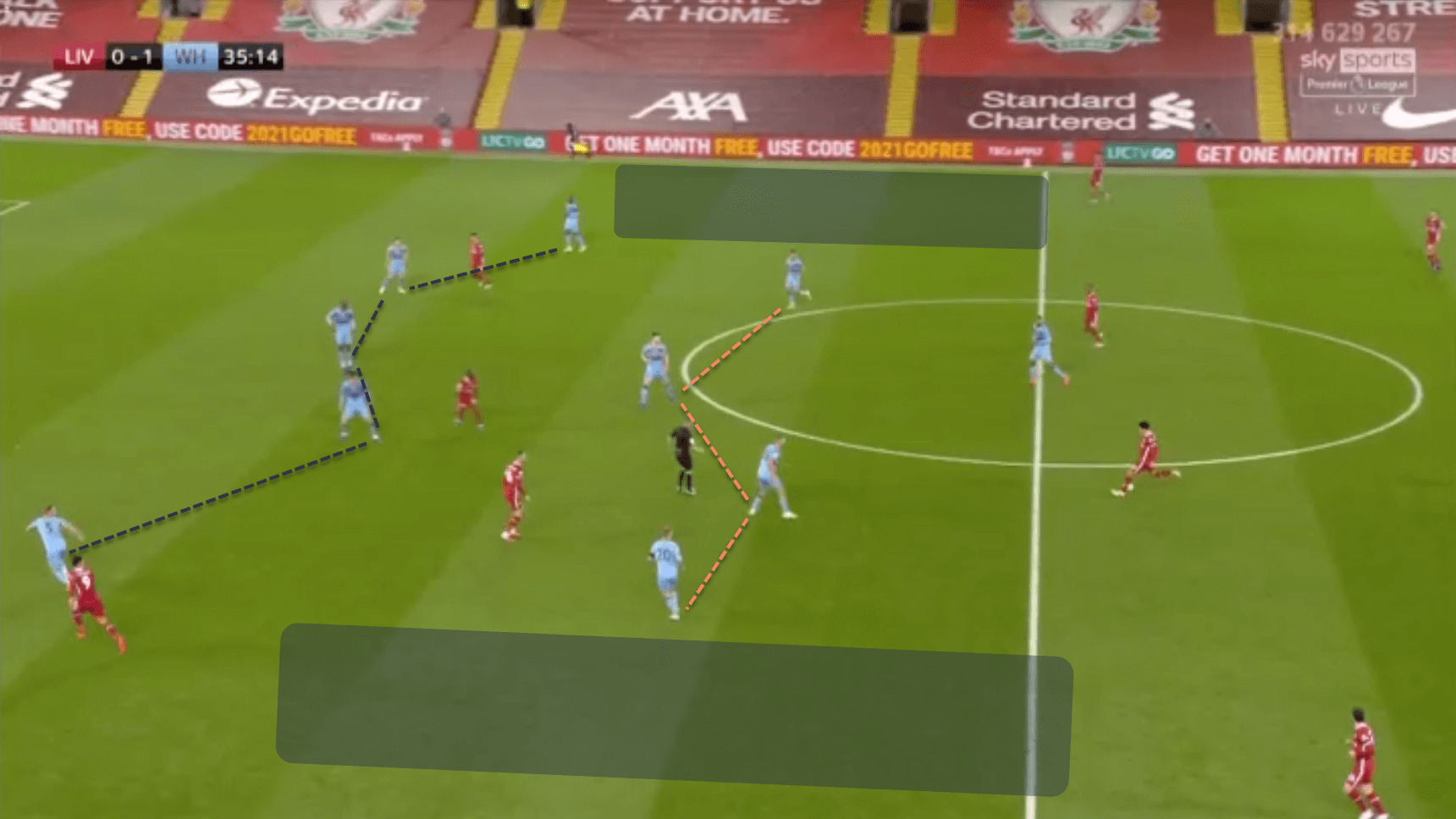
This is a great example of West Ham’s defensive shape this season. The back five are fairly narrow, with the wing-backs looking to track the wide runners, while the four-man midfield is also extremely compact horizontally. The primary aim is to congest the centre and reduce space, forcing teams to go out wide into the highlighted areas, or try to play long passes over the defence, as Curtis Jones is doing here, which can be mopped up by the defence.
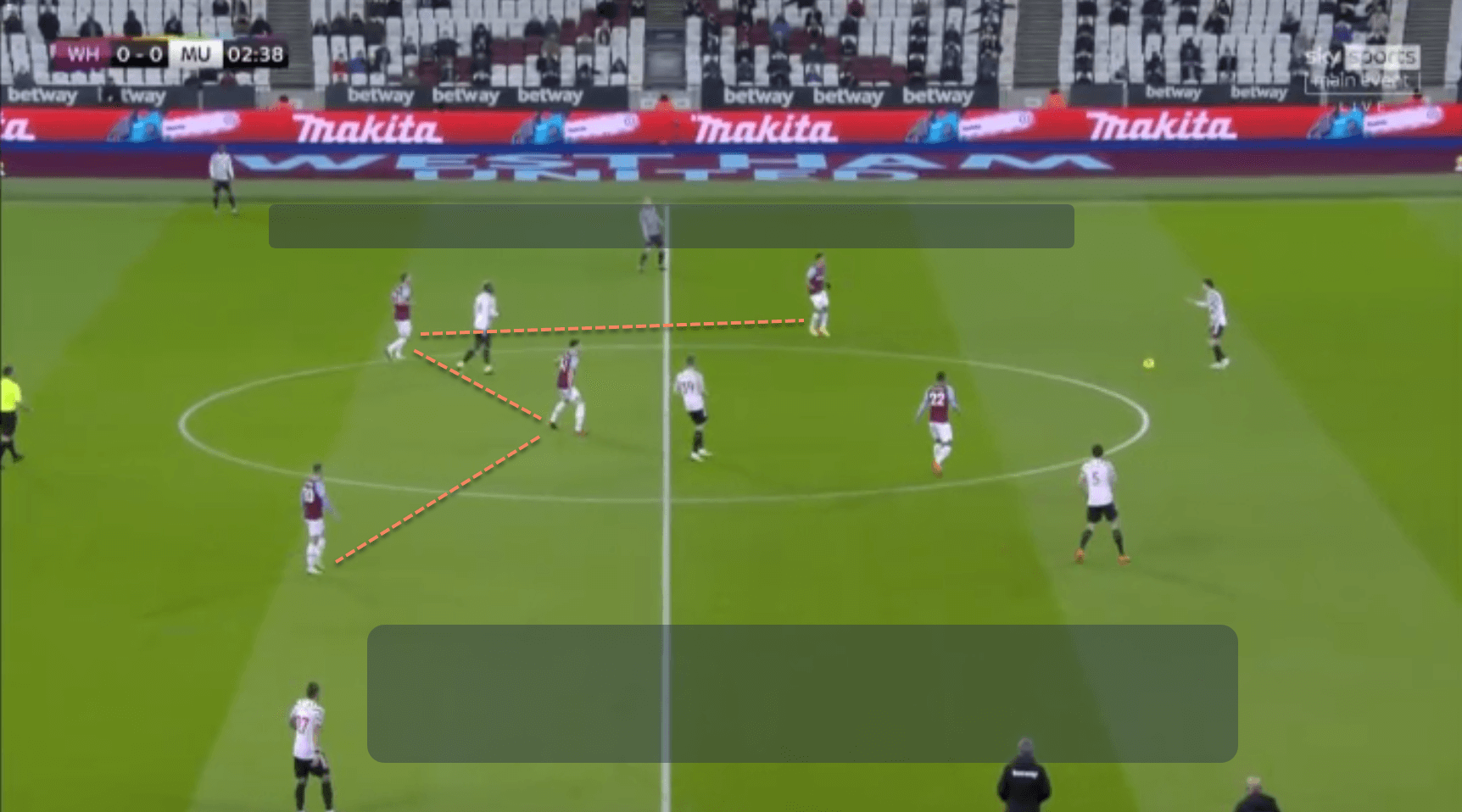
Another instance, this time from the game against Manchester United, of West Ham’s midfield staying extremely narrow, and allowing the opposition space on the flanks while denying it centrally. This has been a key tactic for Moyes this season, especially against the ‘bigger’ teams, as a way to reduce dangerous opportunities.
It is also notable that this strategy has remained the same whether West Ham have played with a back four or back five.
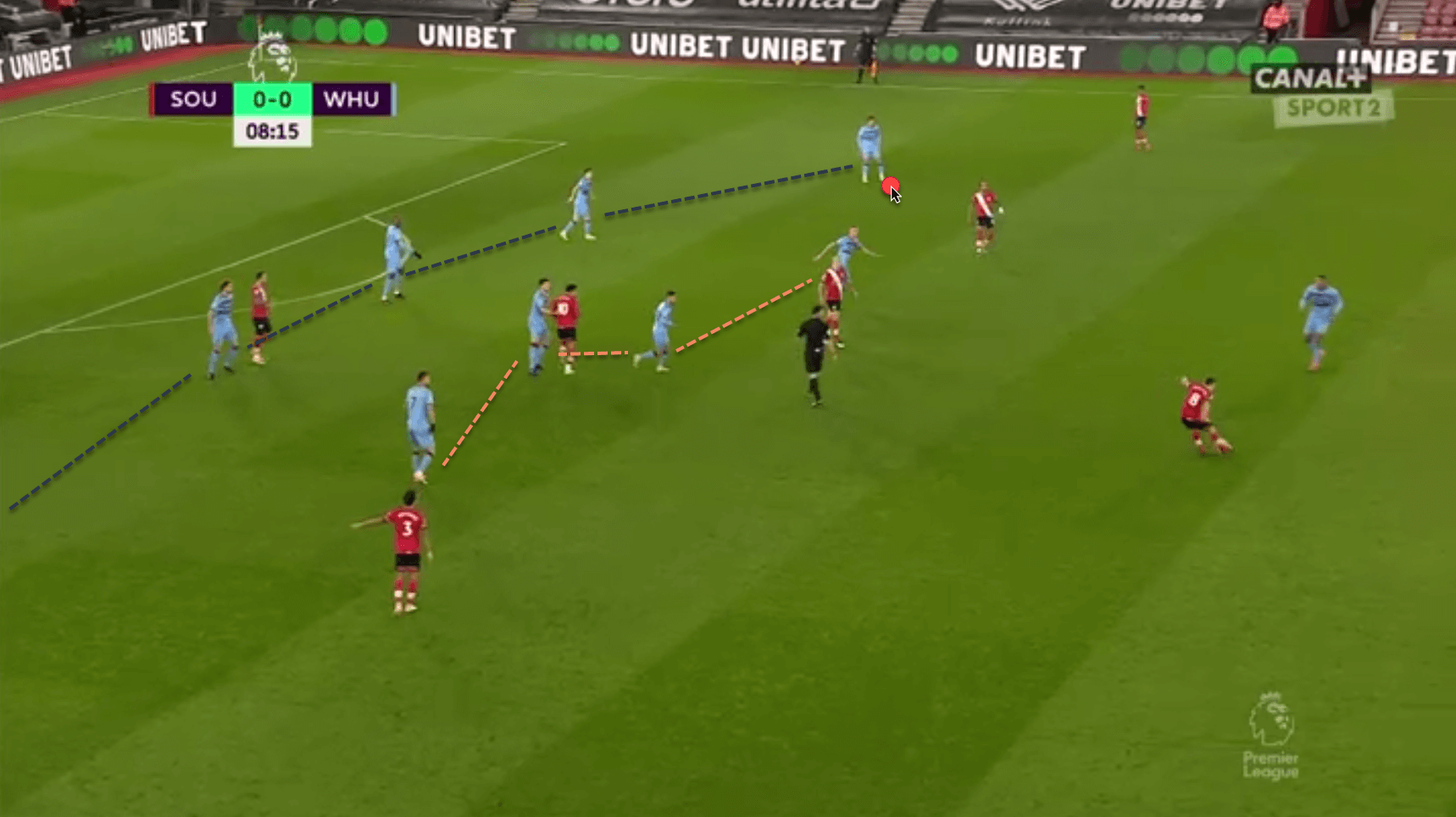
At first glance, this image may make it seem as though the Hammers are playing in a back five. Upon closer inspection, however, we realize that it is a back four, with the winger on the left (red marker) having retreated to play almost as a wing-back in the defensive phase, and the near-side winger having tucked in centrally to form a narrow, flat midfield four. This is a good example of Moyes’ strategy without the ball this season – stay narrow and compact, and form a back five to defend the penalty area, with the wing-backs picking up wide runners.
Doing so also allows the Hammers some security if a defender does need to step out of the defensive line. Teams will often look to have their attackers drop off and come short against such systems, both in an attempt to gain space in between the lines, and tempt defenders out to create space in behind. West Ham’s narrow, deep midfield, combined with three central defenders during the defensive phase, means that one of the centre-backs can step out to engage opposition attackers who are dropping off, with the security of at least three-four defenders behind him if the ball does get played behind him.
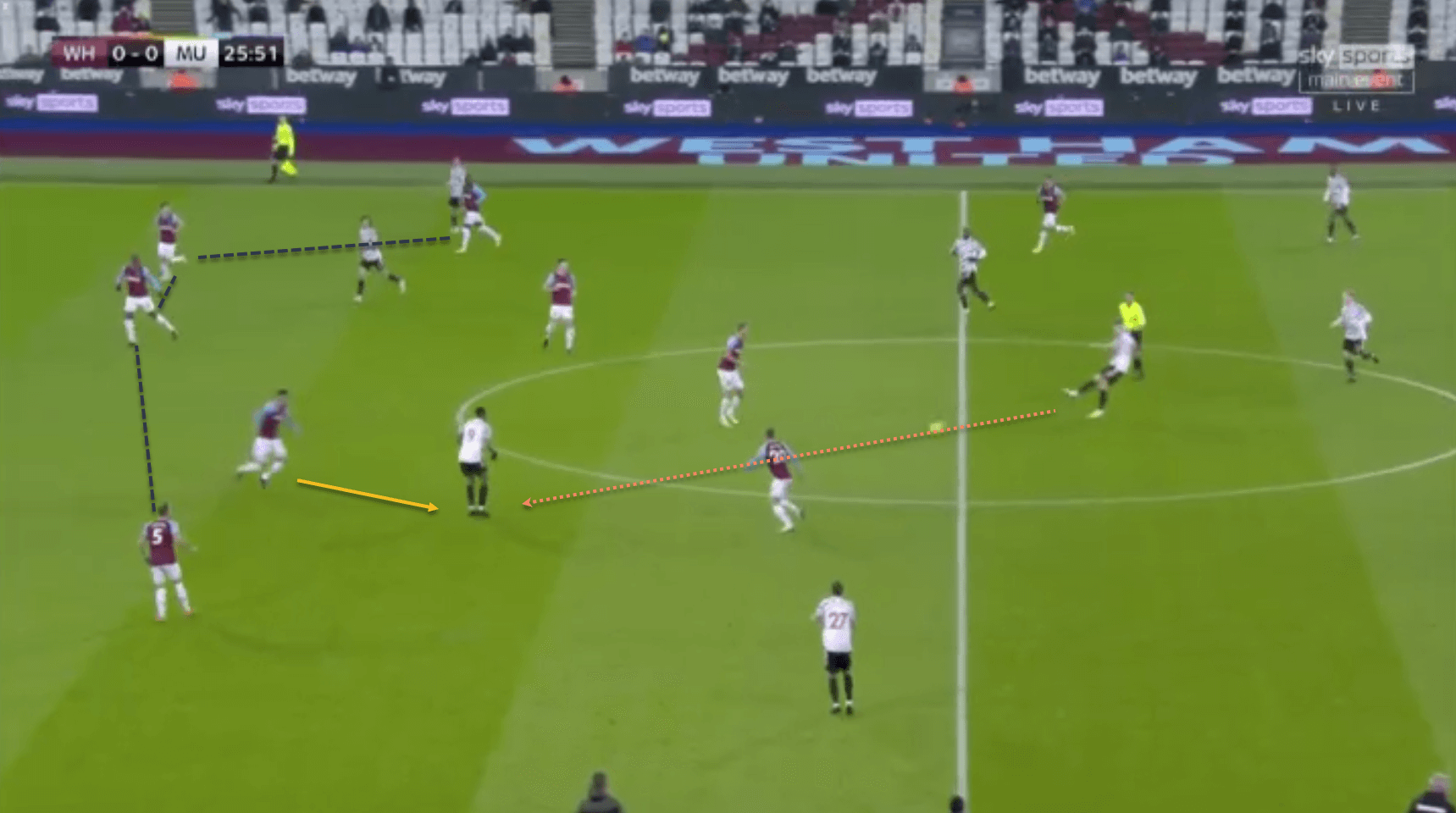
Here, Anthony Martial has dropped into a central position from his initial starting position on the left. Rather than the wing-back following him and opening up a huge gap, Fabián Balbuena steps out to engage him when the pass is made. There are enough defenders back for the Hammers to deal with any pass that may be played in behind; however, there are no United attackers in close proximity to Martial, which also reduces the likelihood of a quick combination being played to take advantage of the space. Thus, the Paraguayan’s actions are well-timed and allow him to win the ball back for the Hammers here.
These may seem like the basics of defensive play, but their importance cannot be overstated. Moyes has successfully been able to have West Ham playing to their strengths defensively, and this has allowed them to be much better and even outperform their defensive metrics so far this season.
Attacking efficiency
Moyes has improved West Ham’s attacking play this season as well. While the side do sit deep during spells of opposition possession, they have been able to be extremely dangerous on the counter-attack. The likes of Jarrod Bowen, Michail Antonio and Pablo Fornals have been excellent at carrying the ball upfield at pace, while the wing-backs, Masuaku and Vladimir Coufal, have also provided support from wider areas.
As we saw earlier, West Ham’s midfielders sit narrow while defending. This allows them to be able to play quick combinations when the ball is won back, with one of the wider midfielders pushing wide to then create a passing option down the flank. This allows them to progress up the pitch rapidly. The individual qualities of the players also play well with this approach. Bowen and Fornals are good at running with the ball at pace, especially the former Hull City winger, while the likes of Andriy Yarmolenko and Saïd Benrahma have fulfilled similar roles when they have played. Michail Antonio’s absences through injury meant that Sébastien Haller played up front, and provided a dynamic presence who could get involved in those quick passing moves before releasing an attacker out wide. Of course, he has now been sold to Ajax, with West Ham in the market for another striker in this window, but even though the Frenchman may have been a disappointment in terms of his goalscoring, he did offer a lot of qualities in other ways on the pitch. Along with this, one of the two central midfielders would also push on to join the attack – it would usually be the Czech Tomáš Souček, but Declan Rice was often the player breaking from midfield as well. This meant that West Ham often had as many as six players counter-attacking rapidly, and this has been an extremely effective way for them to create chances this season.
We will now look at a counter-attack from the game against Everton, which sums up their attacking approach perfectly.
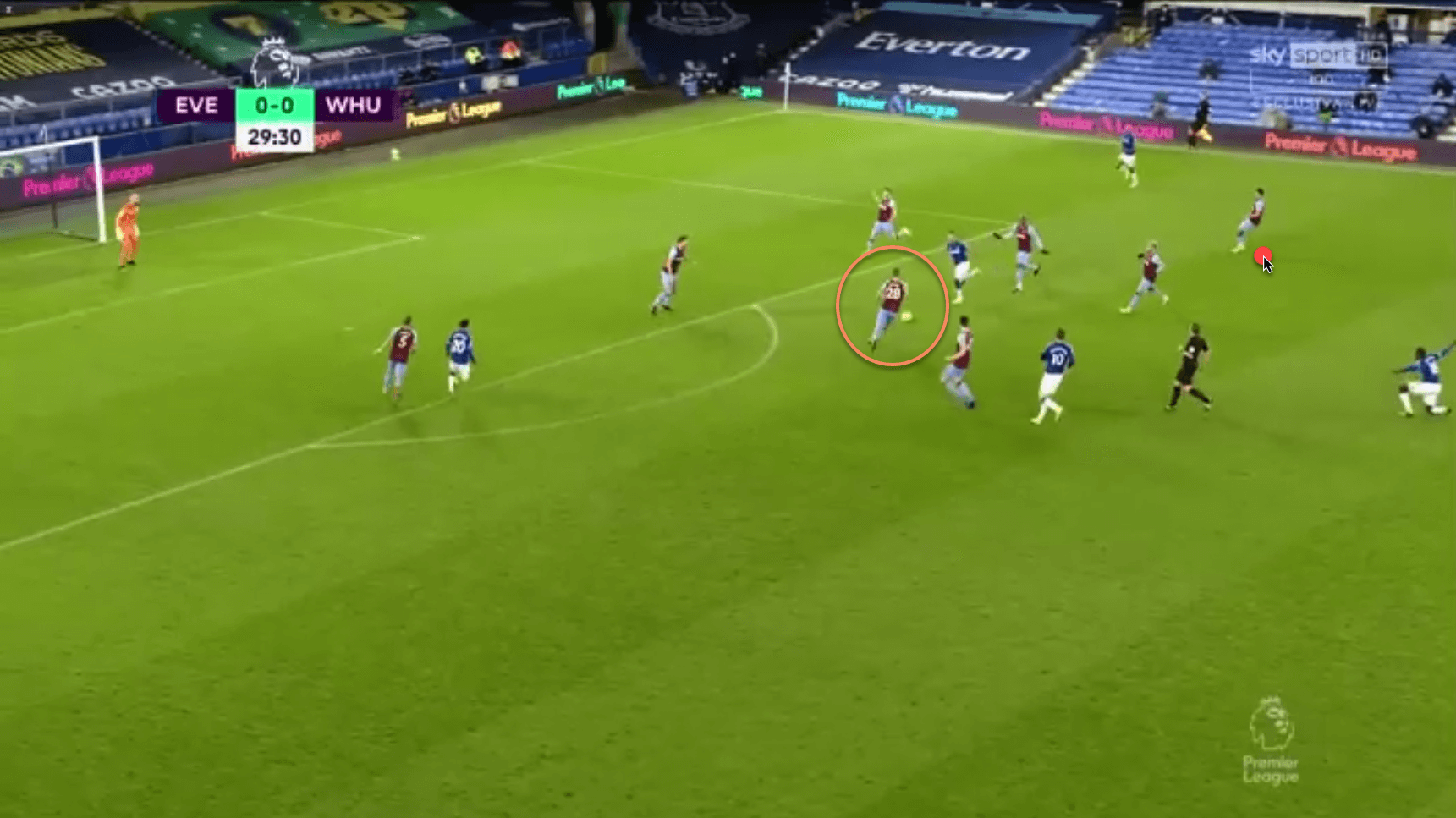
The move starts with Souček winning the ball back just outside his own penalty area. Note that Fornals (red marker) is in a relatively wide position, allowing for a counter-attack to be sprung almost immediately.
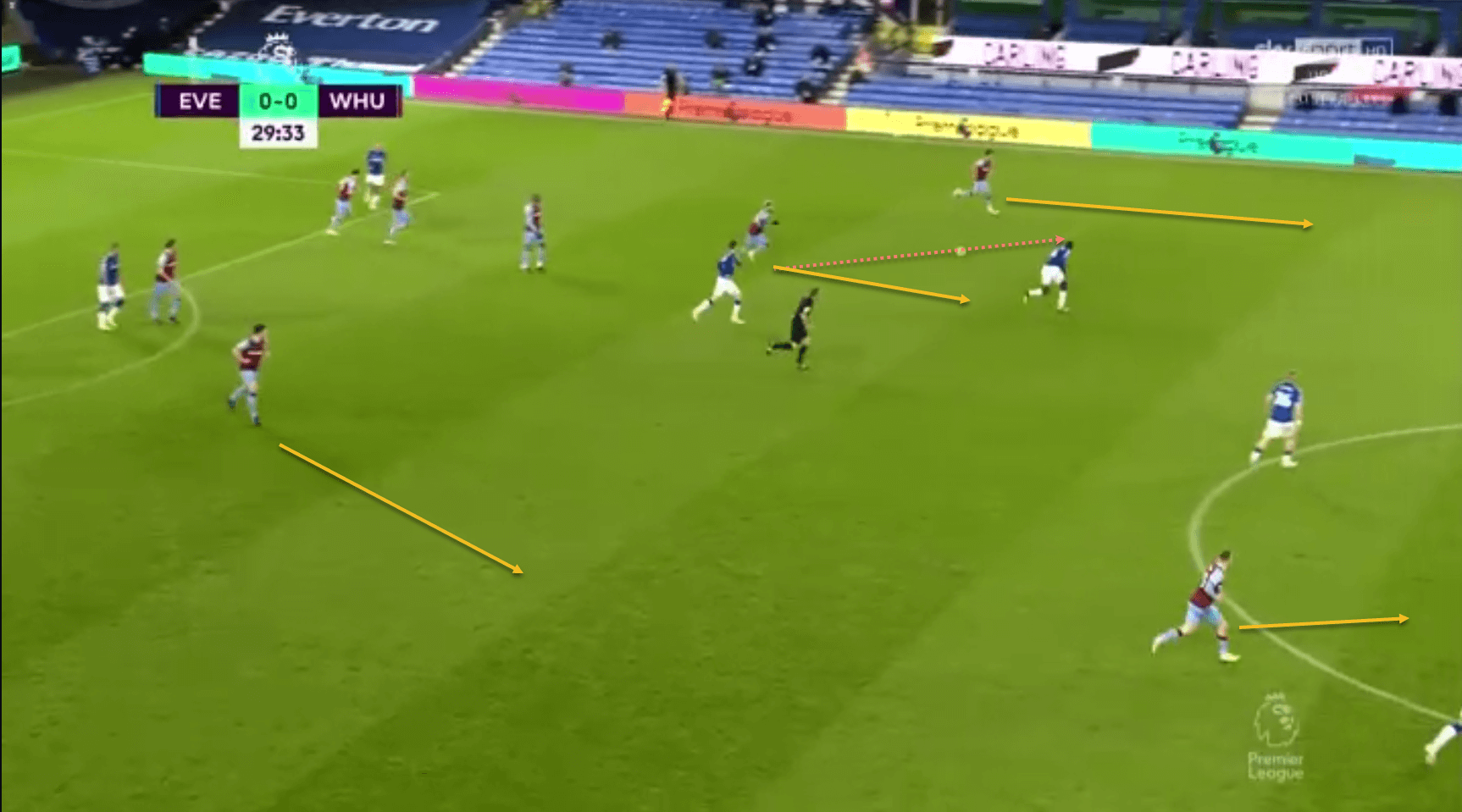
The ball is played to Benrahma, who then plays Fornals into space down the left. Given that Souček is in a deeper position, having won the ball back, Rice begins to make a run forward, while Benrahma and Bowen also do the same.
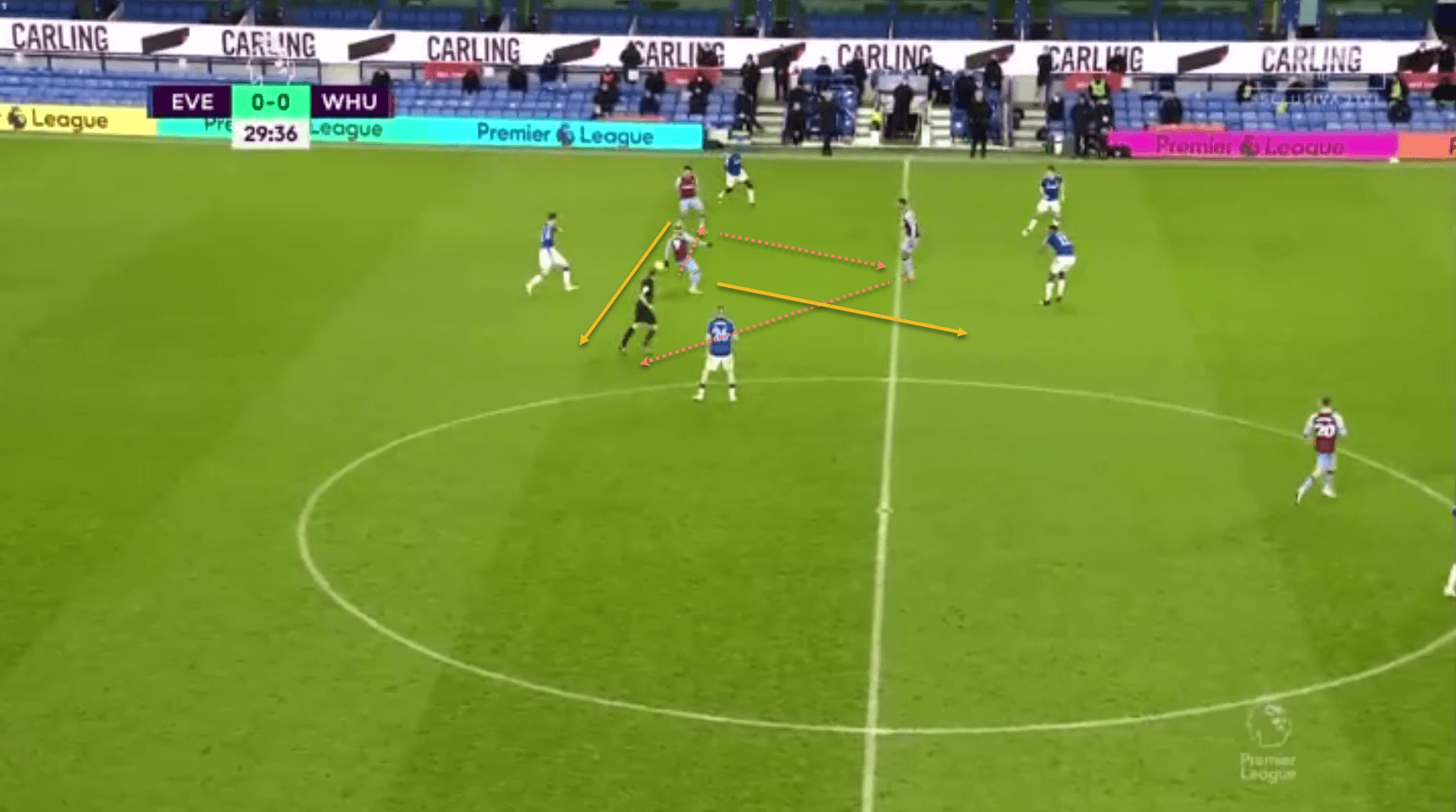
Here we see the quick combination play we spoke about earlier. Fornals, having played the pass to Benrahma, receives it back from him and then quickly shifts it to Haller, who has dropped deep. The Frenchman takes a touch and plays it back to Fornals, who, by now has moved infield from his wider position. Benrahma, meanwhile, has also made a forward run. Note that this quick move attracts five Everton players to West Ham’s left, opening up a lot of space on the opposite flank. Also take note of Bowen’s advanced position, which creates space centrally for Benrahma and Haller to move into as well once the ball has been laid off.
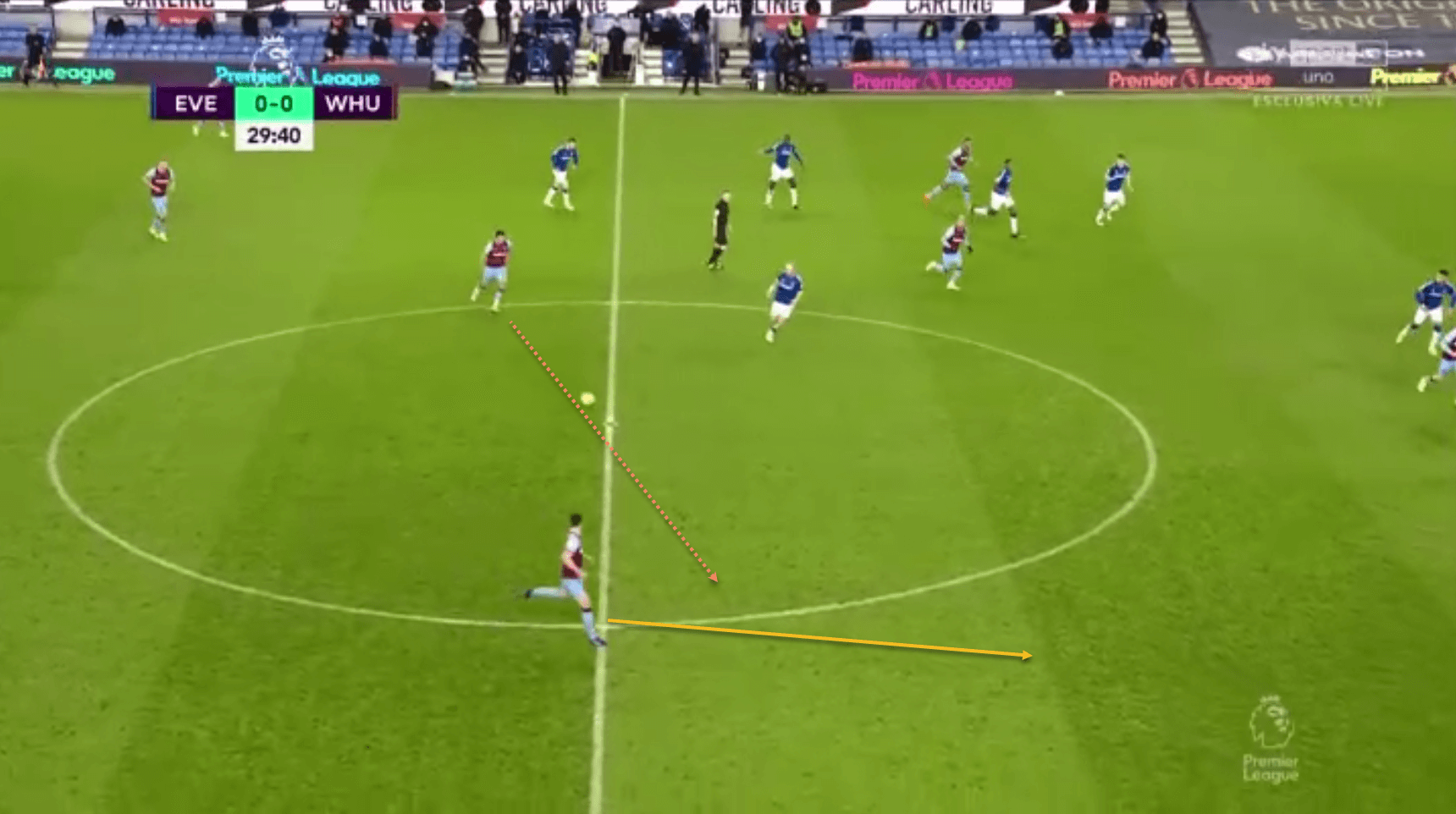
That wide space is occupied by Rice, who receives the ball from Fornals with a lot of room ahead of him to drive into.
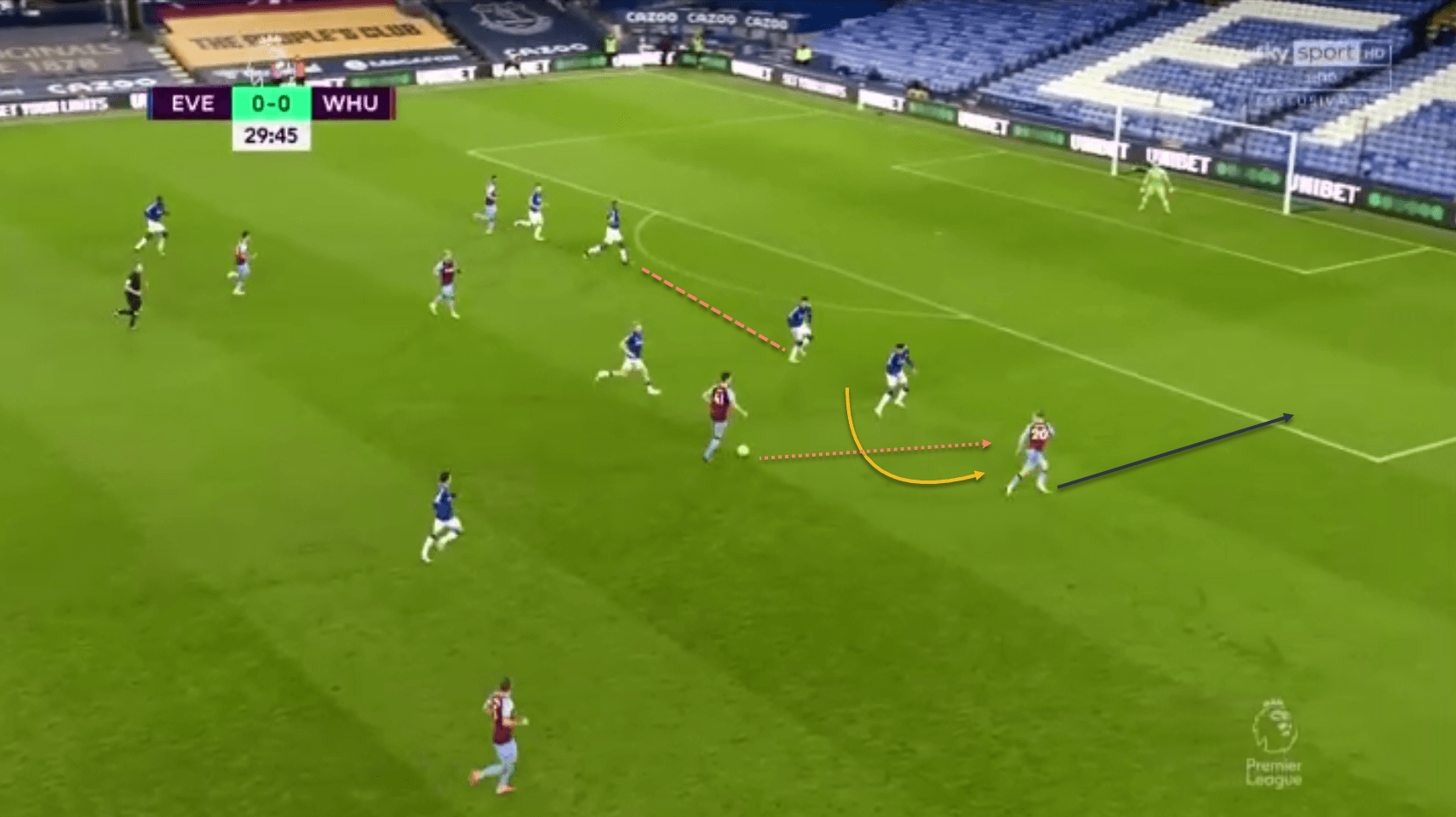
Rice moves upfield, with a number of teammates in support. Bowen makes a run outside from his previous central position, which draws the Everton defenders towards him. Along with the positioning of Haller, this means that there is a gap centrally in the Everton defence, which will soon be taken advantage of. Rice plays Bowen into the box…
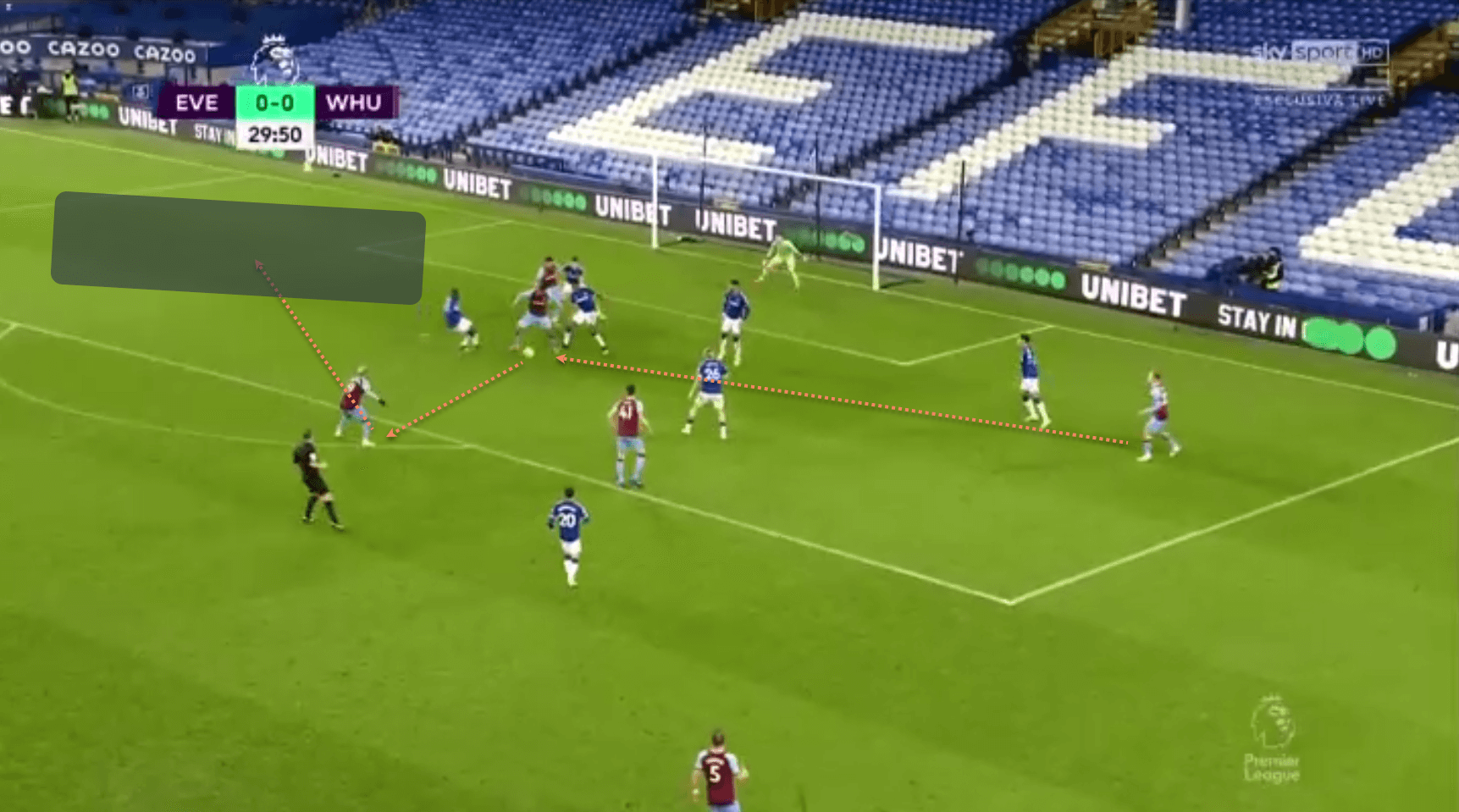
…from where he finds Haller with a pass. The Frenchman is able to lay the ball off to a completely unmarked Benrahma on the edge of the box, who is then able to play the ball into the left side of the box, which has been left completely empty and from where the onrushing Aaron Cresswell shoots narrowly wide.
This move did not result in a goal, but it is a great example to show West Ham’s attacking traits. They aim to spring rapid counter-attacks, moving the ball quickly, and with rapid combinations in midfield to draw defenders in, which creates space out wide and in behind for the likes of Bowen, Benrahma, Fornals and Yarmolenko to take advantage of. The aim is also to then try and creaete separation centrally for the attackers to take advantage of, while overlapping full-backs/wing-backs are also a threat.
Another area where West Ham have improved immensely is at attacking set-pieces. The Hammers have scored four goals from corners already this season, which is the fifth-highest in the league so far. Our set-piece analysis has explained their tactics from such situations in more detail, but this is another way in which Moyes has managed to improve West Ham’s attacking threat this season as well.
Excellent transfer business
West Ham had become something of a byword for wasteful transfer spending over the last few years. There have been a large number of players who have been brought in for significant fees, or loan deals and free signings on high wages, who have flattered to decieve and have not delivered anywhere near expectations. Haller is the most recent example of this, having been West Ham’s record signing, but now being sold at a considerable loss to Ajax. However, under Moyes, this seems to have changed. Of course, the Scotsman cannot take full credit perhaps for these signings, but it is undeniable that player identification has improved tremendously under his watch, with the Hammers going for players who fit the way Moyes wants to play, and therefore have been successful.
Last January, the club brought in Bowen from Hull City, while Souček also joined in an initial loan deal from Slavia Prague. Both these arrivals have been transformative, with the Czech international’s deal being made permanent this summer. Bowen has notched five goals and six assists so far in his West Ham career while Souček has scored eight goals, including five this season. The club also brought in Coufal at right-back in the summer , where he has excelled, while also nabbing another highly-rated Championship prospect in Benrahma, in an initial loan deal with an obligation to buy next summer. Even Craig Dawson, who arrived on loan from Watford, has now begun to have an impact at the back after initially struggling to get into the side. This has been a major difference-maker for West Ham, given their struggle in the transfer market over the last few years, and Moyes and his team must be credited with getting their player identification spot on so far.
Conclusion
David Moyes has made West Ham awkward customers once again. They are difficult to beat, offer a threat from set-pieces, and can be devastating on the counter-attack. West Ham’s resurgence this season has gone a long way towards rehabilitating Moyes’ reputation in England, and it will be very interesting to see where they end up in the table. One thing is for sure though that the Hammers will not be involved in a relegation battle this season, and that alone marks progress for the club.





Comments